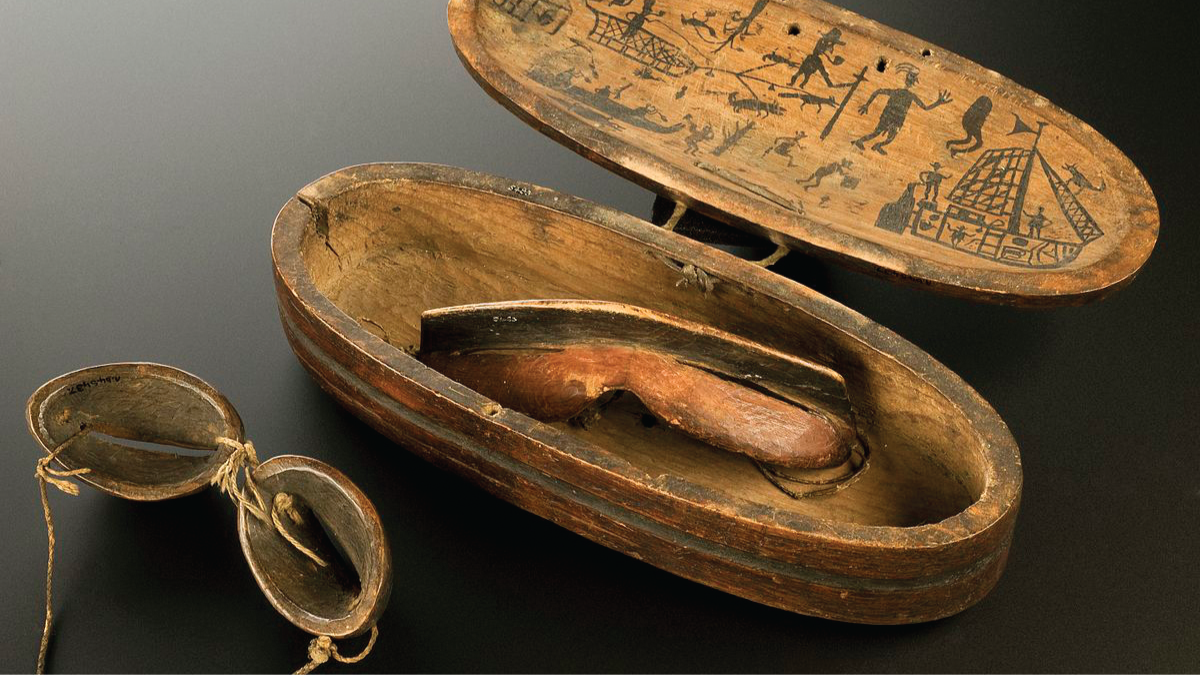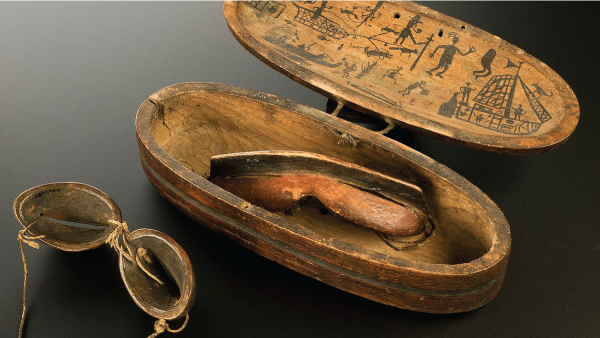The Ancient Origins of Sunglasses
The Ancient Inuit people were far ahead of their time when it came to protective eyewear
Ancient Inuit culture had many different ideas about the sun. Groups in Greenland thought of it as a goddess named Malina, whereas in Canada they called it Siqniq, referring to a ball of fire that revolved around the Earth’s flat, stationary body. But while the sun’s influence on the surrounding snow-covered arctic environment may have been minimal, for the eyes concerned with interpreting its cultural significance, it posed a number of issues.
Prolonged exposure to sun-reflected ice or snow can cause a form of photokeratitis, an eye condition that causes inflammatory reactions in ocular tissues as a result of ultraviolet (UV) radiation. In fact, more than 80 to 90 percent of sunlight that falls on fresh snow casts back towards space. Eyes that are insufficiently protected can suffer what is often called sunburn of the cornea and conjunctiva, with symptoms typically noticeable just a few hours after subjection. This includes eye lacrimation and a feeling of pain not dissimilar to having sand beneath your eyelids. If left untreated, it can cause permanent blindness.
Alexander Macklin, a surgeon in Ernest Shackleton’s trans-antarctic expedition, counted this ocular sunburn as one of four disabilities – along with scurvy, frost-bite and sea-sickness – experienced during their polar expeditions. The Royal Geographical Society’s “Hints for Travellers” from 1893 suggested that “[blackening] the skin around the eyes, and the adjacent part of the nose, is a good deal employed by natives of high mountain regions in some parts of the world as a preventive treatment of snow blindness.” Another ancient remedy involved applying a wet compress over the eyes. Today, artificial eye drops are the most common approach; once the source of the damage disappears, healing usually occurs within 24-72 hours.
Inuits were a nomadic people who spent much of their time hunting and fishing across the Arctic. This, unbeknownst to them, significantly increased their exposure to UV rays. Modern snow-bound explorers rely on snow goggles or sunglasses that allow only a small percentage of light through to protect them against high-glare environments, but such technology didn’t exist thousands of years ago. Instead, the Inuit people constructed – with ingenuity and first-class survival instincts – what many describe as the first sunglasses (or goggles).
Made of natural materials, such as wood, antler, bone, or ivory, the snow goggles were designed to remain durable in the austere conditions of the Arctic. They had long, horizontal slits big enough to see through yet small enough to protect the eyes from glare or blowing snow. Moreover, the earliest models – which date back to the first centuries – were found in Alaska and Siberia, which suggests that the eyewear was worn by Inuit groups dispersed across many miles.
The goggles fit tightly against the face and, as the Royal Geographical Society noted, would occasionally be accompanied by soot applied to the inside of the frames. Their curved shape also provided an unobstructed field of vision, as well as preventing the buildup of condensation from body heat and breath. Interestingly, it was common for the frames to be embroidered in unique patterns and designs – such as dots, lines, and indented pathways. They even varied according to climate, geography, and access to raw materials. For example, Inuits based in the Aleutian Islands used visors. Some suggest the snow goggles functioned in a manner similar to corrective eyewear too. As it happens, the horizontal slit focuses the light just like a pinhole camera. Far-off objects, therefore, appear sharper to the naked eye.
The accomplishments of ancient Inuit culture, including but not limited to the invention of sunglasses, are among the greatest feats of human survival and adaptation. Despite being few in number, they managed to develop and engineer numerous essential tools and technologies that continue to inspire and inform contemporary invention and understanding.
The New Optometrist Newsletter
Permission Statement
By opting-in, you agree to receive email communications from The New Optometrist. You will stay up-to-date with optometry content, news, events and sponsors information.
You can view our privacy policy here
Most Popular
Sign up to The New Optometrist Updates
Permission Statement
By opting-in, you agree to receive email communications from The New Optometrist. You will stay up-to-date with optometry content, news, events and sponsors information.
You can view our privacy policy here
Sign up to The New Optometrist Updates
Permission Statement
By opting-in, you agree to receive email communications from The New Optometrist. You will stay up-to-date with optometry content, news, events and sponsors information.
You can view our privacy policy here







